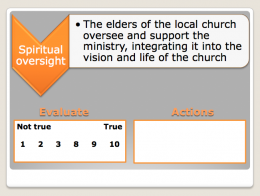 In the first post of this new series I introduced the concept of a Ministry Health Check using the Key Indicators of Good Practice which have been discussed previously.
In the first post of this new series I introduced the concept of a Ministry Health Check using the Key Indicators of Good Practice which have been discussed previously.
What is the purpose?
The Key Indicators have application in two areas: 1) Planning and 2) Evaluation. For planning they underpin more formal planning practices, as described in the previous Series (Jan-March). This provides a useful reference list. Planning should not be completed without intentionally going through this list and comparing it with your proposed protocols and activities to ensure nothing has been omitted.
For evaluation a colleague and I have worked these Indicators into a battery of material that is designed to help you carry out the Check, to record the results and discussions, and to agree any actions. The resulting agreed actions should then be fed back into the next phase of planning and monitoring.
Monitoring and Evaluation
As described elsewhere, but reiterated here to ensure clear understanding, Monitoring and Evaluation are different though essential processes in pursuing ‘good practice’ with your ministry.
Monitoring is part of an on-going process which needs to be carried our both regularly and frequently. Many teams would monitor progress at a weekly review meeting.
Evaluation is carried out at major mile-stones in the progress of a ministry. This may be annually, or at the end of a distinct phase. That is the time to use the Ministry Health Check.
The purposes of Evaluation are to:
- Confirm Vision and Values
- Make an objective assessment of activities and performance
- Make a critical review of results, comparing ‘intentions’ with ‘actuals’
- Learn lessons for future shaping and planning
- Modify the next phase of the ministry to include the lessons learnt
Structure
The Health Check is created around a series of statements. These reflect the Key Indicators of Good Practice. They are grouped in categories:
- Spiritual Oversight
- Ministry Leadership
- Hearing God
- Vision
- Gifting
- Biblical Values
- Gospel
- Change
- Who?
- When?
- How?
- Why?
- Team
- Finance
- Network
- Resources
- Life
To give an example for later discussion, one of the Spiritual Oversight statements reads:
Grading the statements
Each such statement is presented alongside a grading scale 1, 2, 3, 8, 9, 10. A grading of 1 is assigned to a particular statement if it is considered not to apply in any way to that ministry. 10, by contrast, indicates that the statement applies wholly to the ministry.
No gradings of 4 to 7 are possible. It is important for those doing the grading to be forced to focus on one end of the scale or the other, not to be tempted to default to an ‘average’ figure in the middle. This grading is not a score of performance so the figures have no absolute value. They give a way of highlighting areas that may require particular attention.
Next time we will look at some illustrations to show how this is used in practice

